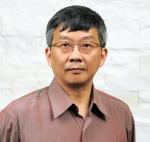Transition between icosahedral and cuboctahedral nanoclusters of lead
- Citation:
- Wei, C. M., Cheng C., & Chang C. M. (2006). Transition between icosahedral and cuboctahedral nanoclusters of lead. Journal of Physical Chemistry B. 110, 24642-24645., Dec, Number 48
Abstract:
We have used ab initio methods to study the possible transition between icosahedral (ico) and cuboctahedral (fcc) structures in lead nanoclusters of sizes up to 309 atoms. Spontaneous fcc-to-ico transition in Pb-13 was observed in the ab initio molecular dynamics (MD) simulations at various temperatures. The transition path can be described predominantly by an angular variable s, which can, generally be applied to the similar transitions in clusters of larger sizes and was observed to follow the Mackay model. We have calculated the two-dimensional energy surface that describes the transition in Pb-13 and found a barrierless fcc-to-ico transition path, which is consistent with the observed spontaneous transition in the ab initio MD simulations. The atomic displacements in the transition were identified as one of the vibrational eigenmodes of these two Pb-13 clusters. For clusters of larger sizes (Pb-n, where n = 55, 147, and 309), the possible transitions following similar paths were determined not to be barrierless and the sizes of the barriers were determined by the ab initio elastic band method.
Notes:
ISI Document Delivery No.: 111CITimes Cited: 5Cited Reference Count: 25Cited References: BLOCHL PE, 1994, PHYS REV B, V50, P17953, DOI 10.1103/PhysRevB.50.17953 Doye JPK, 2006, COMP MATER SCI, V35, P227, DOI 10.1016/j.commatsci.2004.07.009 Doye JPK, 2002, J CHEM PHYS, V116, P8307, DOI 10.1063/1.1469616 FARGES J, 1988, ADV CHEM PHYS, V70, P45, DOI 10.1002/9780470122693.ch2 FARGES J, 1986, J CHEM PHYS, V84, P3491, DOI 10.1063/1.450235 FARGES J, 1983, J CHEM PHYS, V78, P5067, DOI 10.1063/1.445375 FROHEN F, 1983, CHEM PHYS LETT, V99, P500 HENDY SC, 2001, PHYS REV B, V64, P85425 Koga K, 2004, PHYS REV LETT, V92, DOI 10.1103/PhysRevLett.92.115507 KOHN W, 1965, PHYS REV, V140, P1133 Kresse G, 1996, PHYS REV B, V54, P11169, DOI 10.1103/PhysRevB.54.11169 Kresse G, 1996, COMP MATER SCI, V6, P15, DOI 10.1016/0927-0256(96)00008-0 KRESSE G, 1993, PHYS REV B, V47, P558, DOI 10.1103/PhysRevB.47.558 Kresse G, 1999, PHYS REV B, V59, P1758, DOI 10.1103/PhysRevB.59.1758 KRESSE G, 1994, PHYS REV B, V49, P14251, DOI 10.1103/PhysRevB.49.14251 MACKAY AL, 1962, ACTA CRYSTALLOGR, V15, P916, DOI 10.1107/S0365110X6200239X MILLS G, 1995, SURF SCI, V324, P305, DOI 10.1016/0039-6028(94)00731-4 MOLINA LM, 1999, ADV QUANTUM CHEM, V33, P329 NOSE S, 1984, J CHEM PHYS, V81, P511 Perdew JP, 1996, PHYS REV LETT, V77, P3865, DOI 10.1103/PhysRevLett.77.3865 Rao BK, 2000, PHYS REV B, V62, P4666, DOI 10.1103/PhysRevB.62.4666 Roos BO, 2004, PHYS CHEM CHEM PHYS, V6, P2919, DOI 10.1039/b401472n SONNTAG H, 1983, J MOL SPECTROSC, V100, P75 UPPENBRINK J, 1991, J CHEM SOC FARADAY T, V87, P215, DOI 10.1039/ft9918700215 Voter AF, 1987, MATER RES SOC S P, V82, P175Wei, C. M. Cheng, C. Chang, C. M.AMER CHEMICAL SOCWASHINGTON

